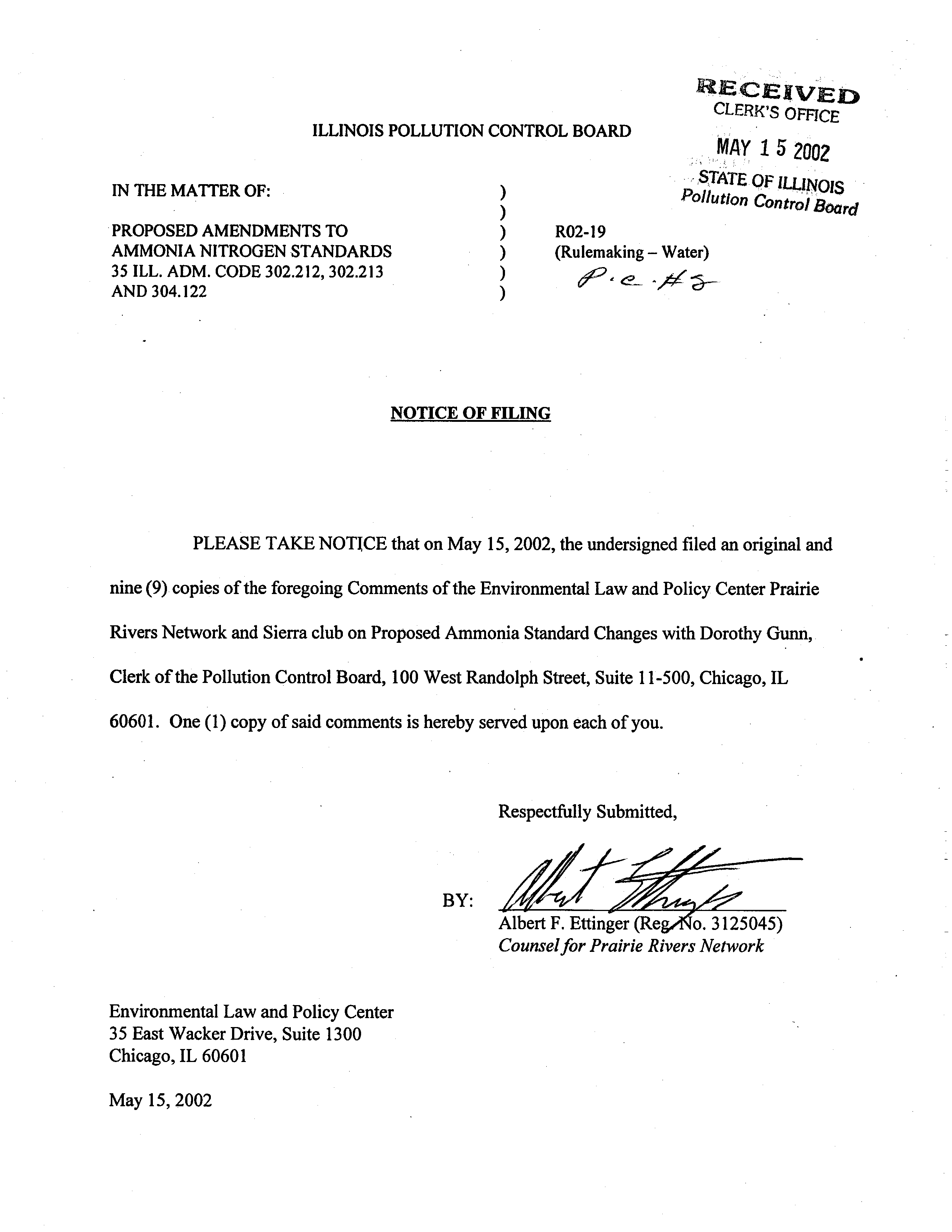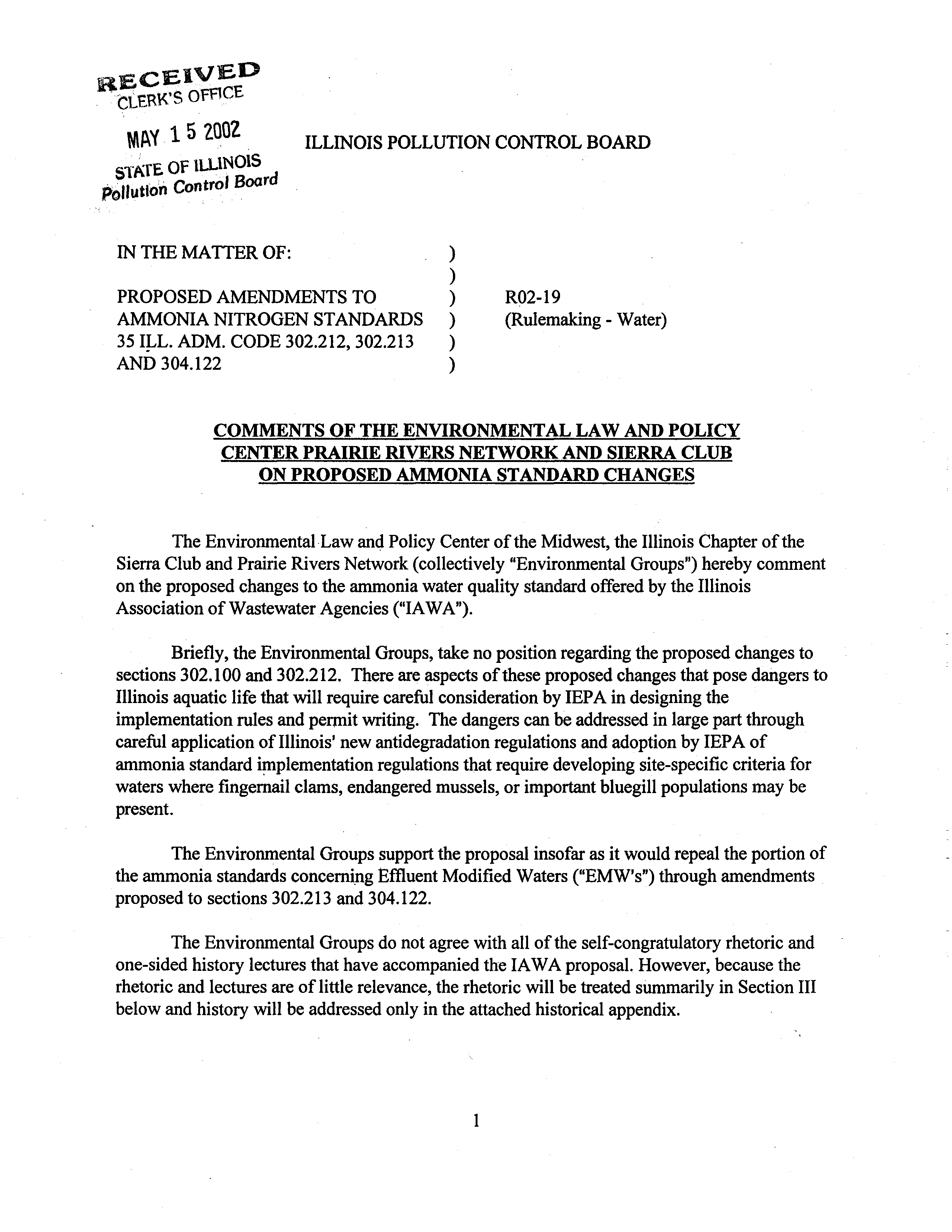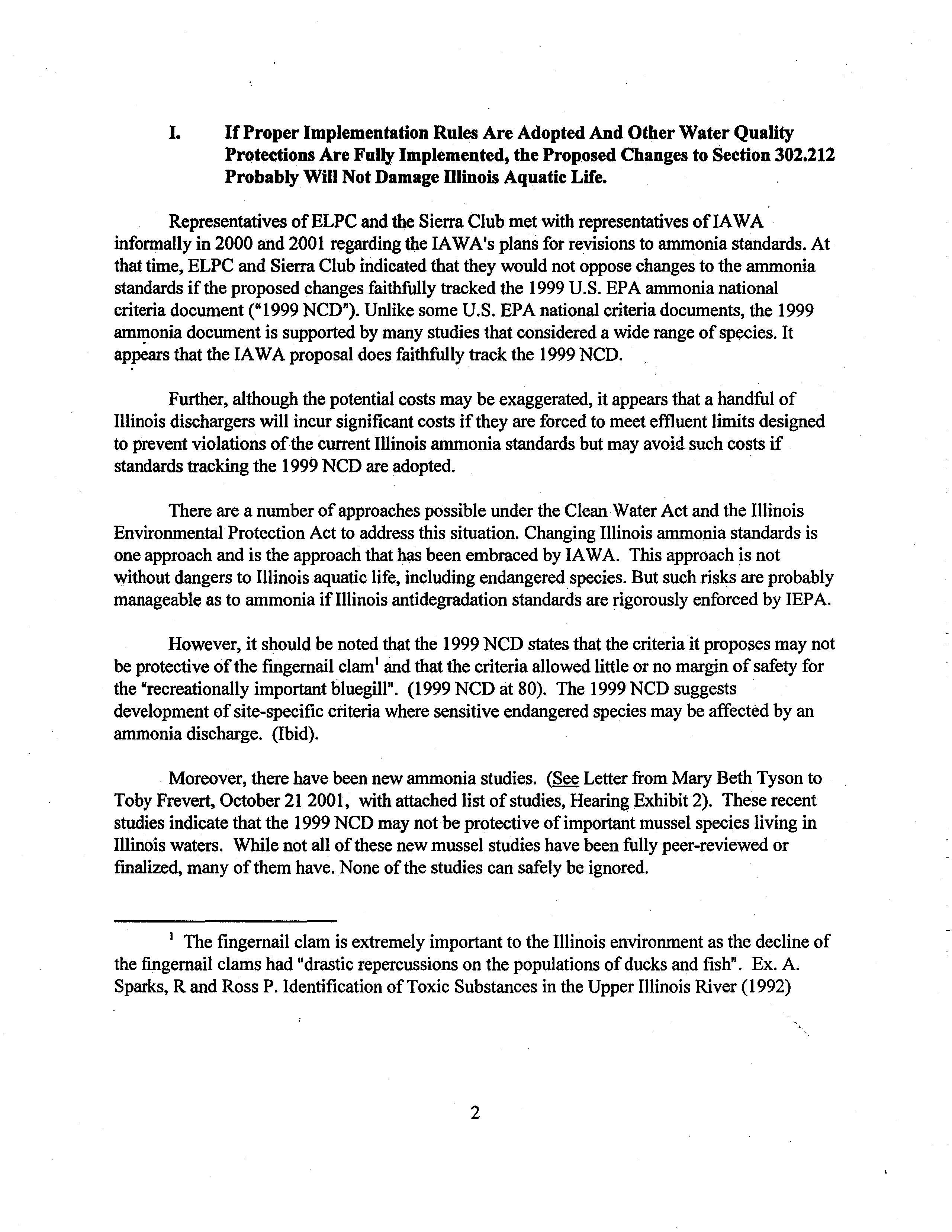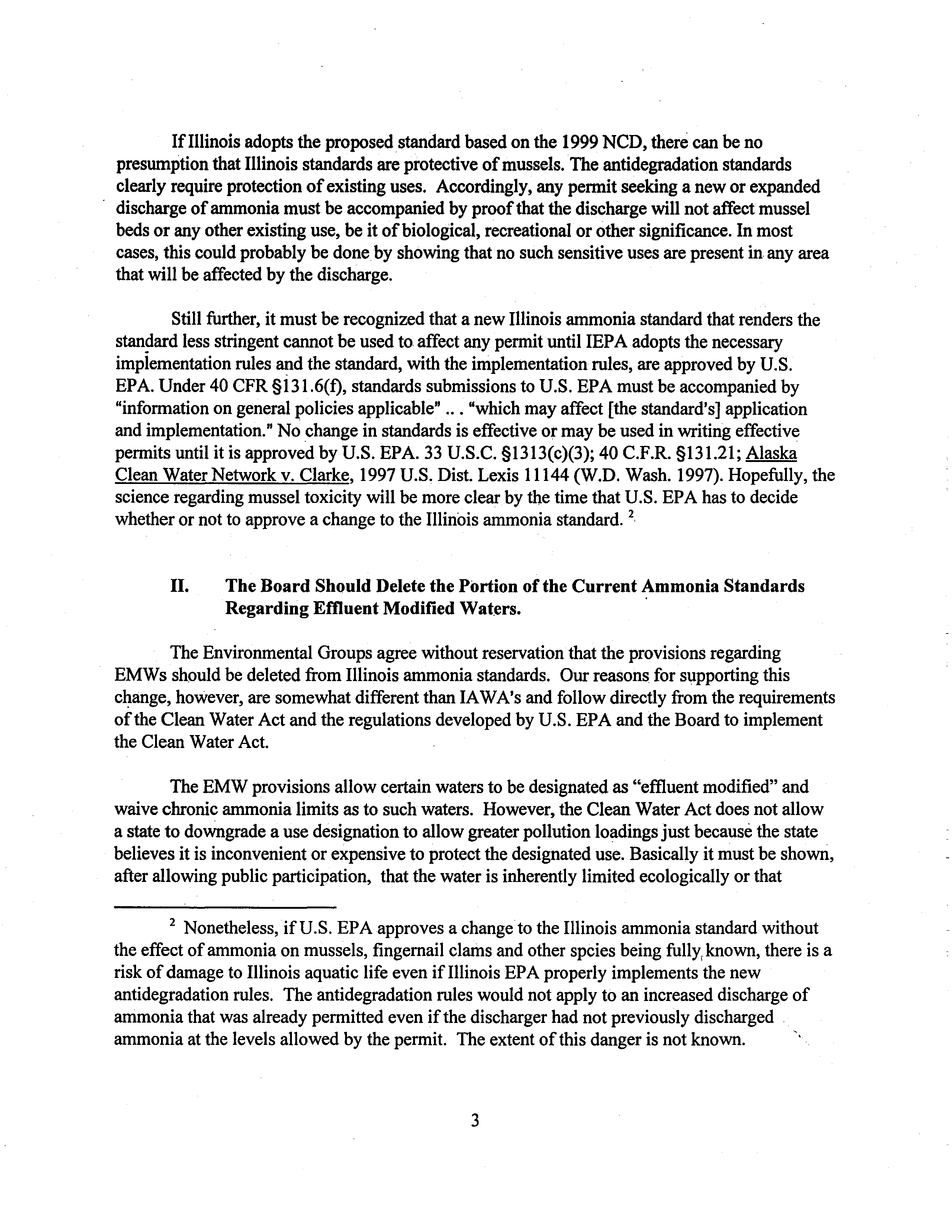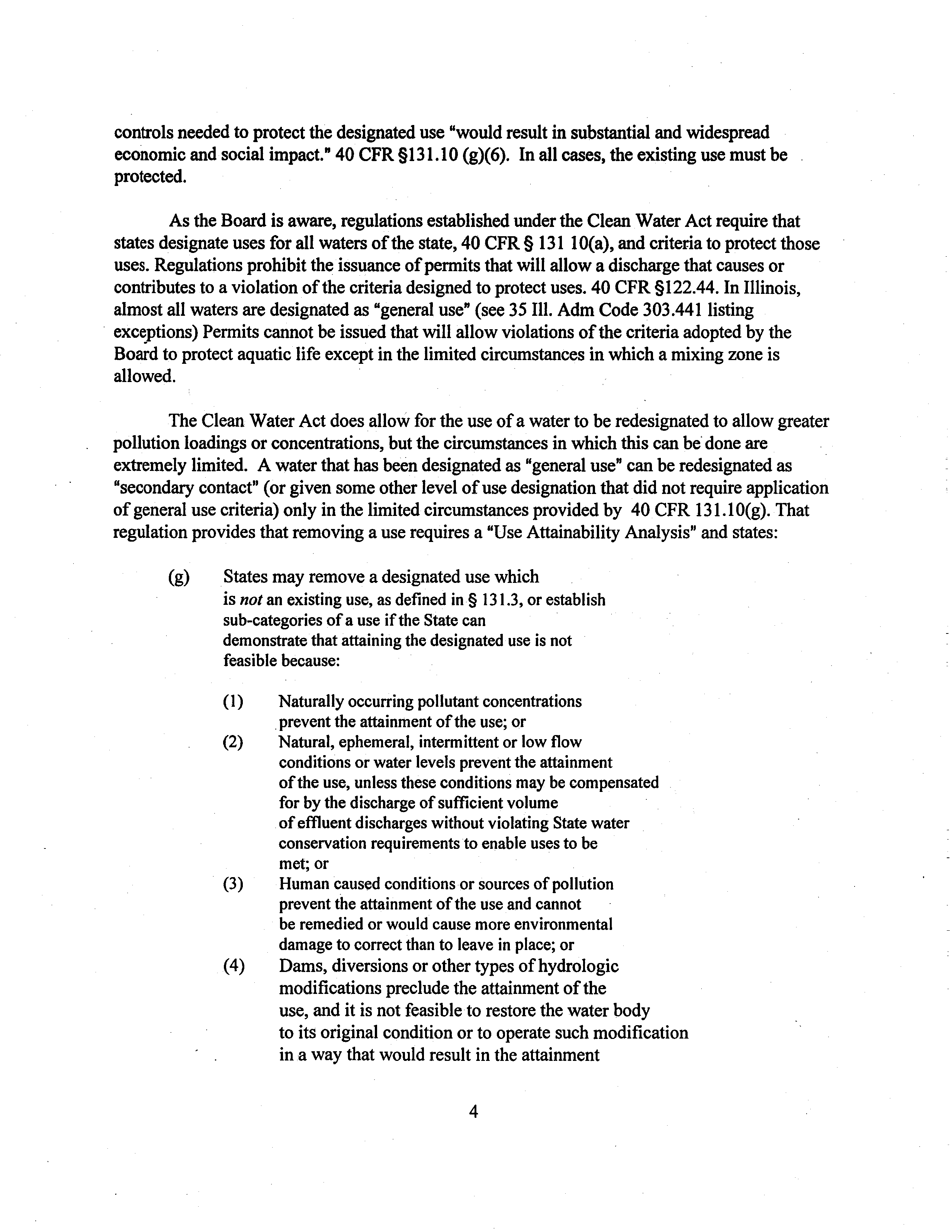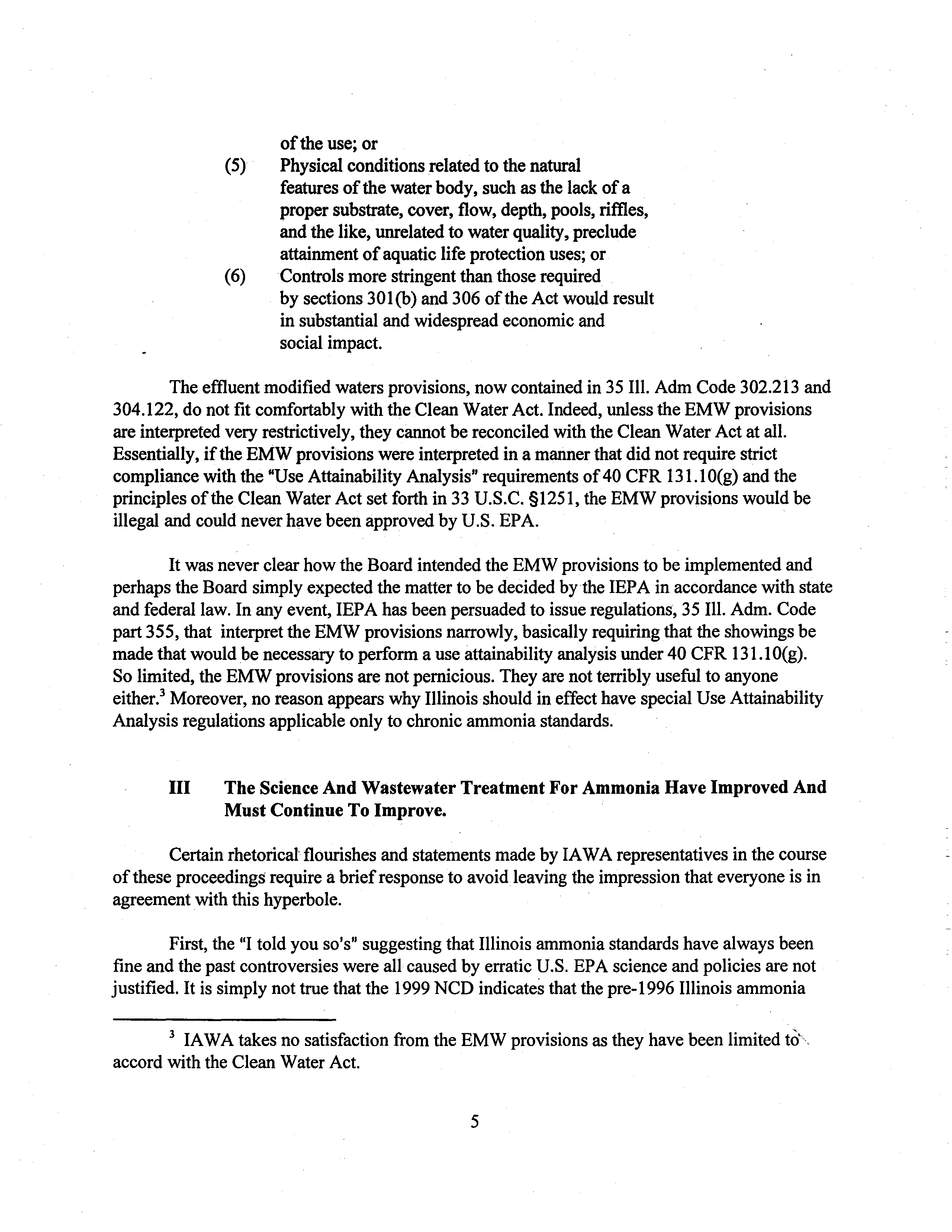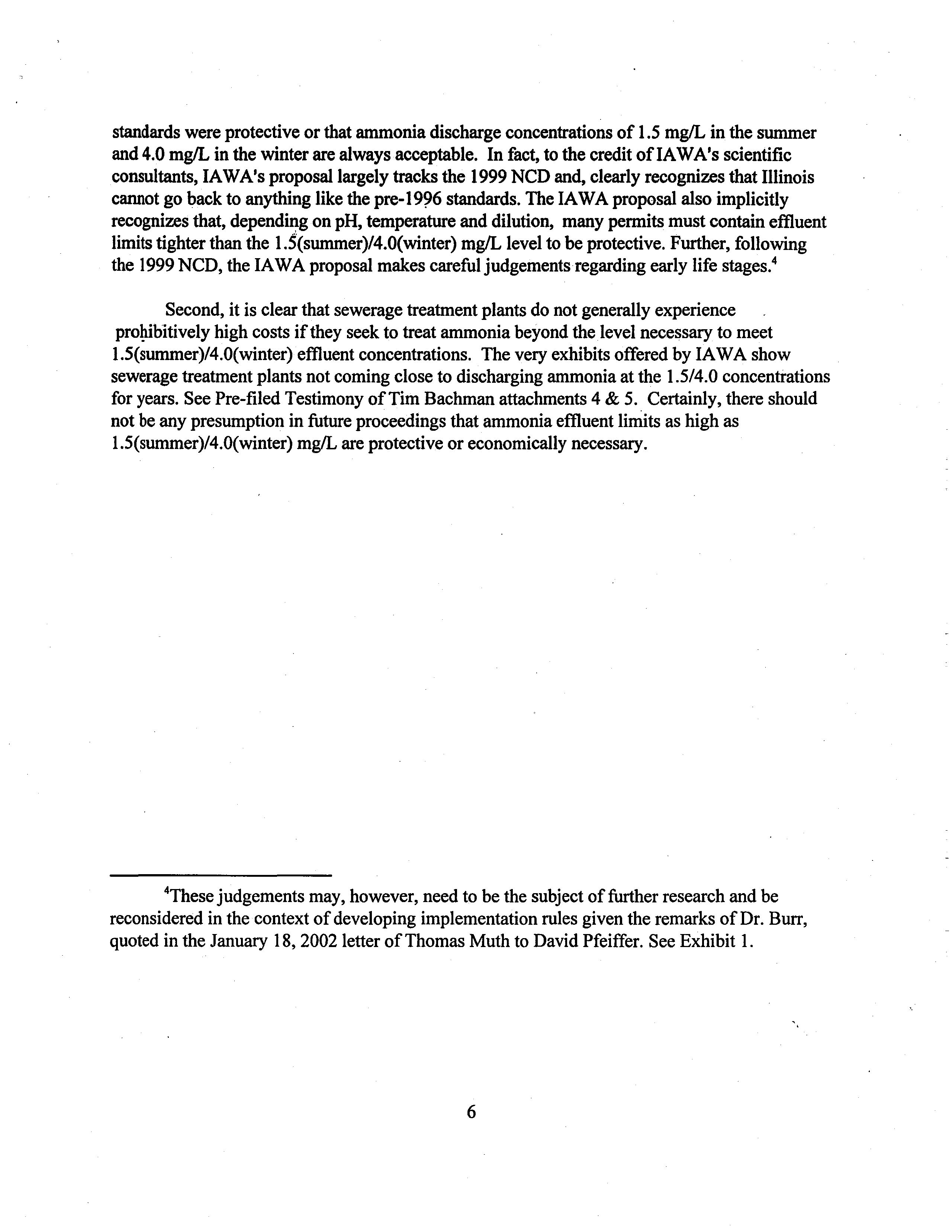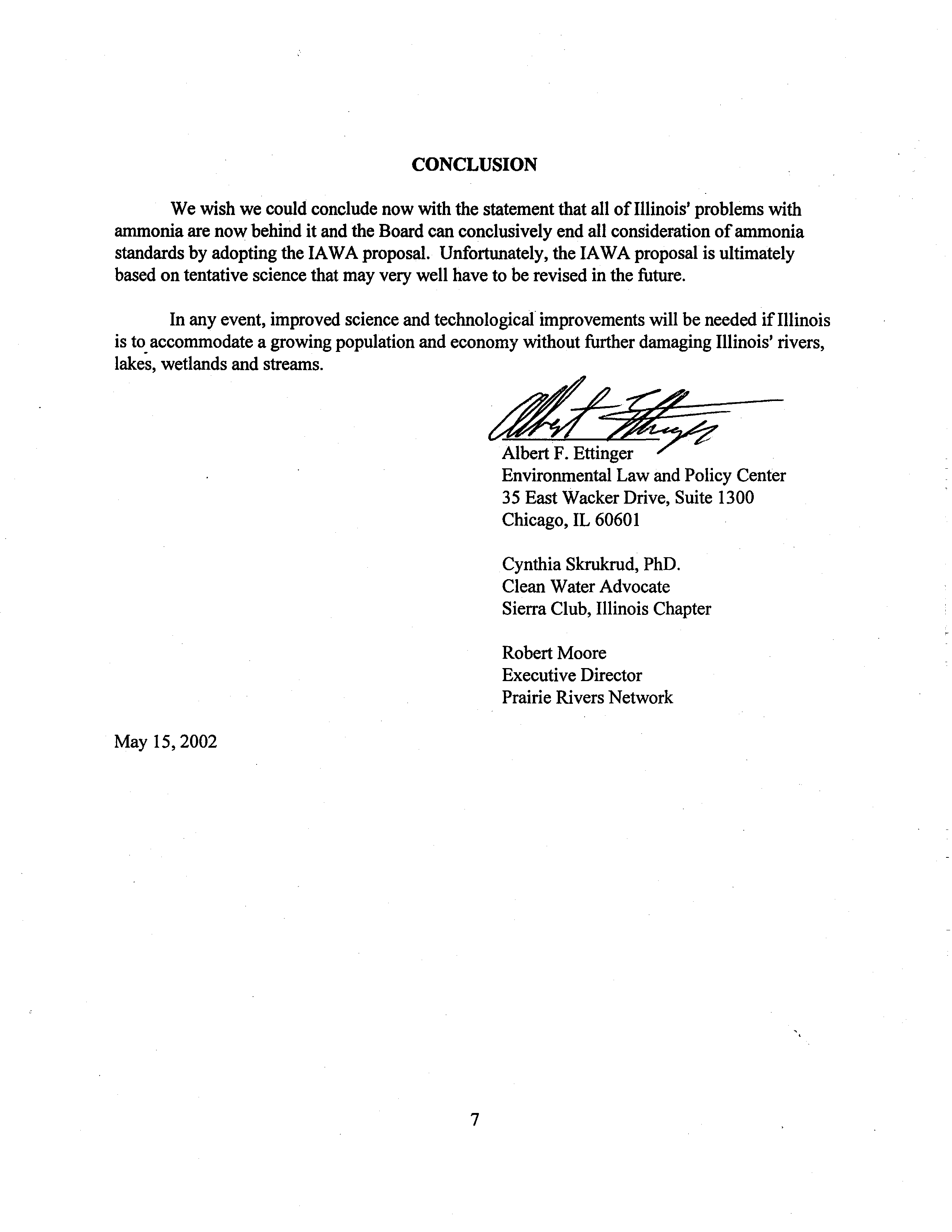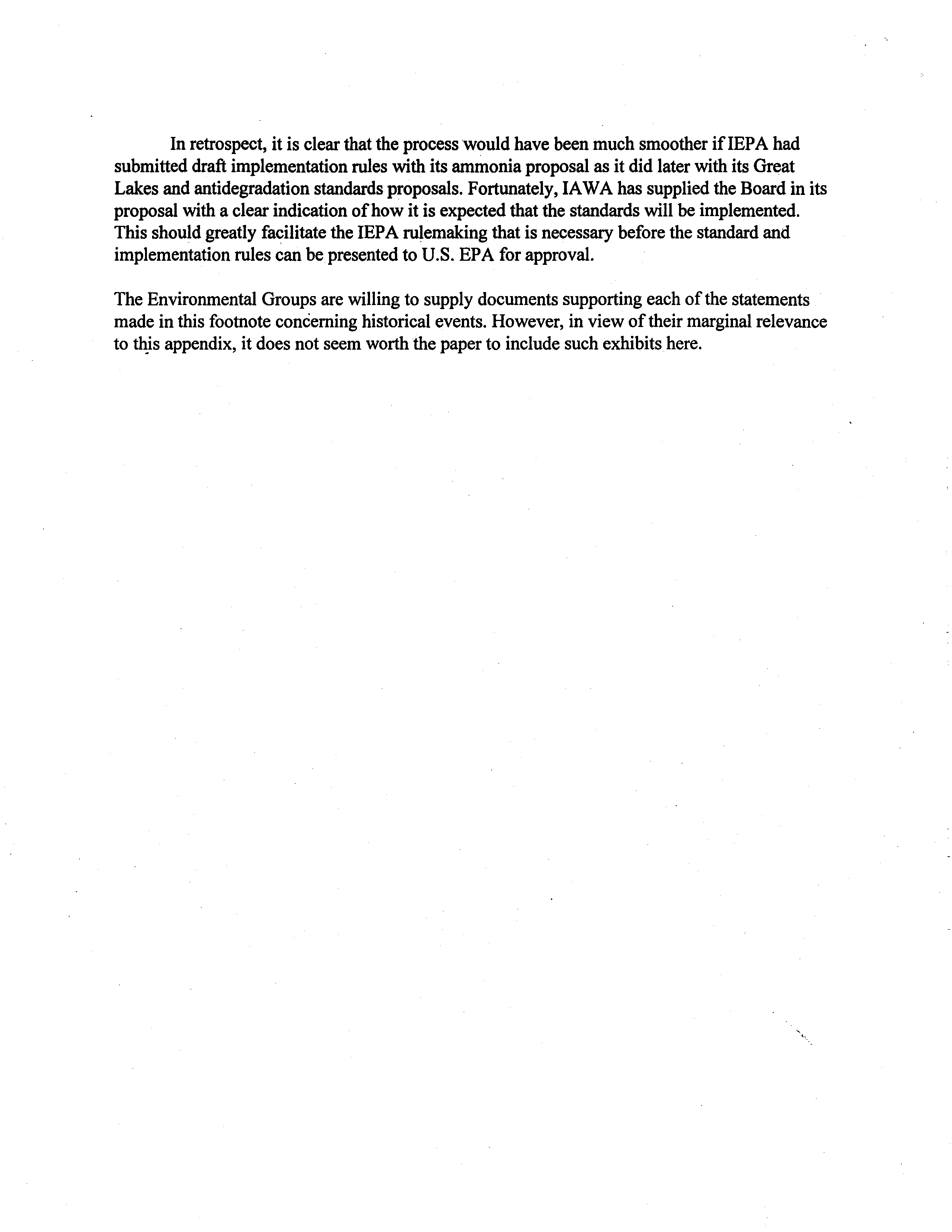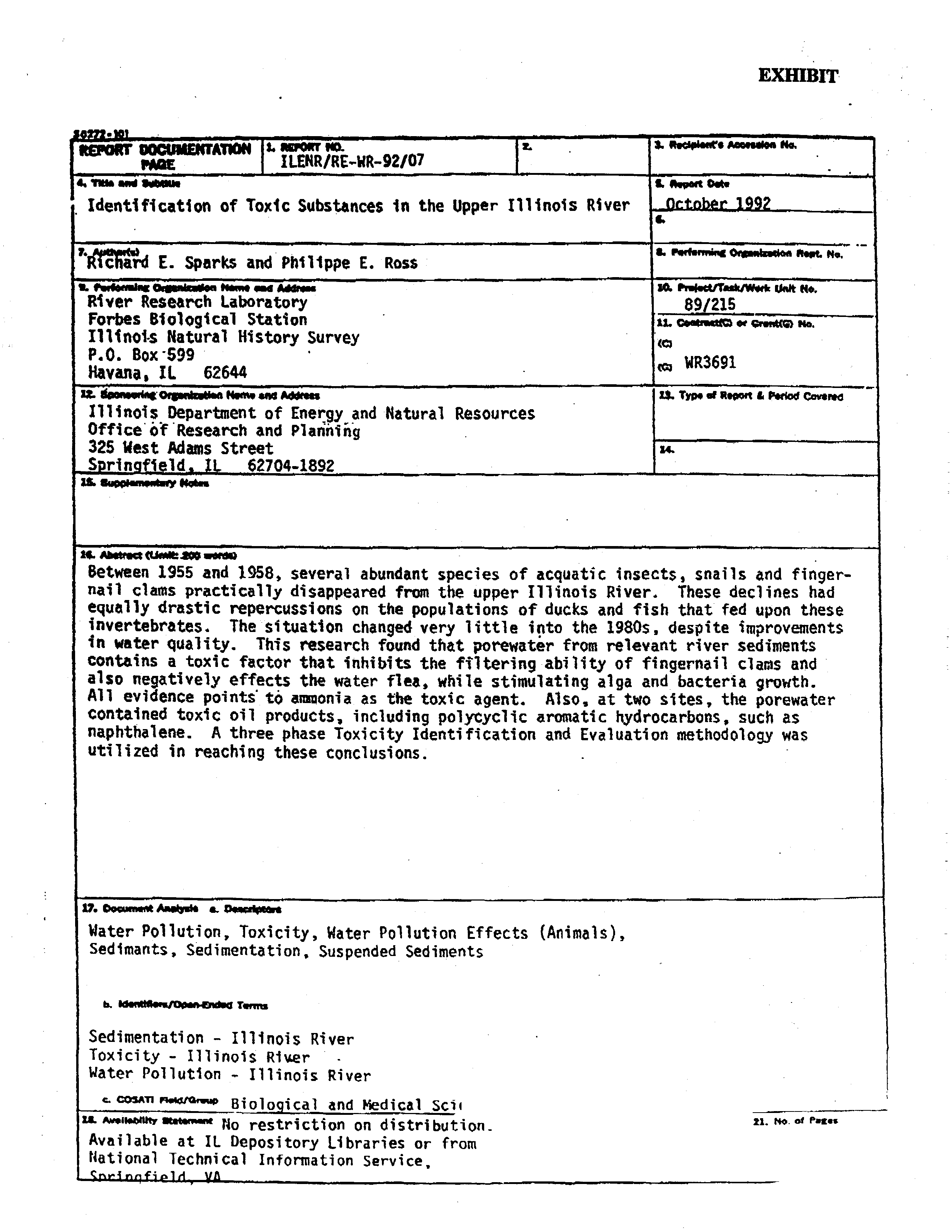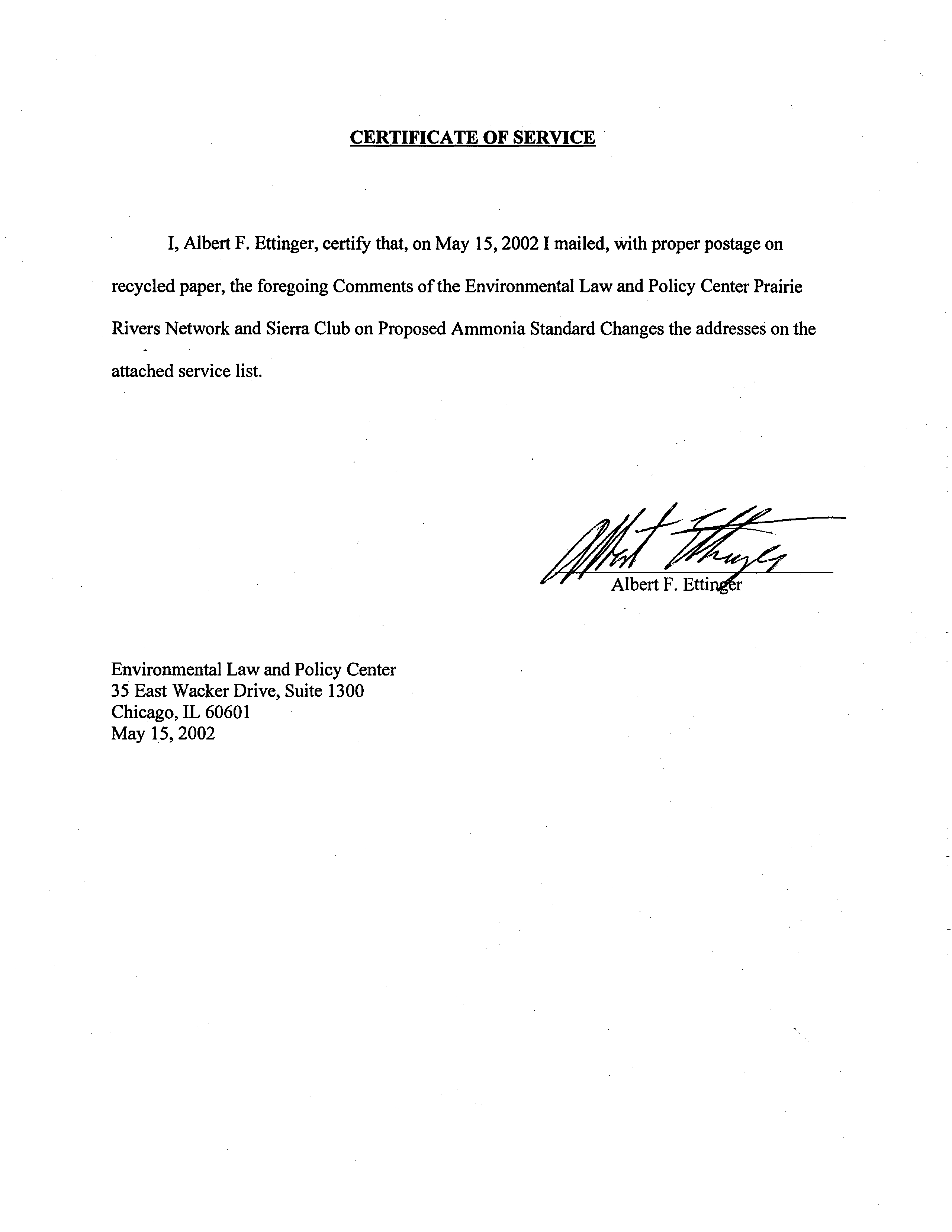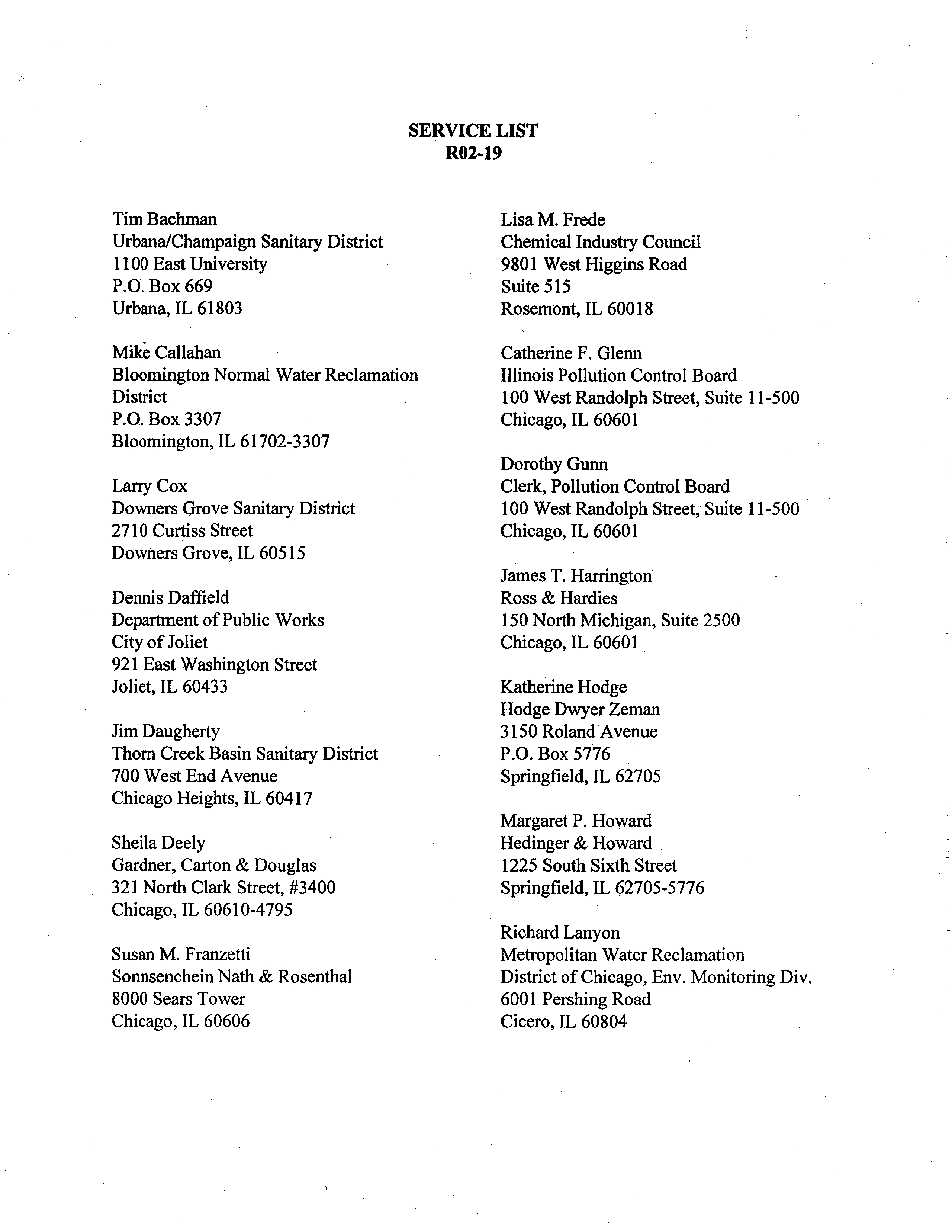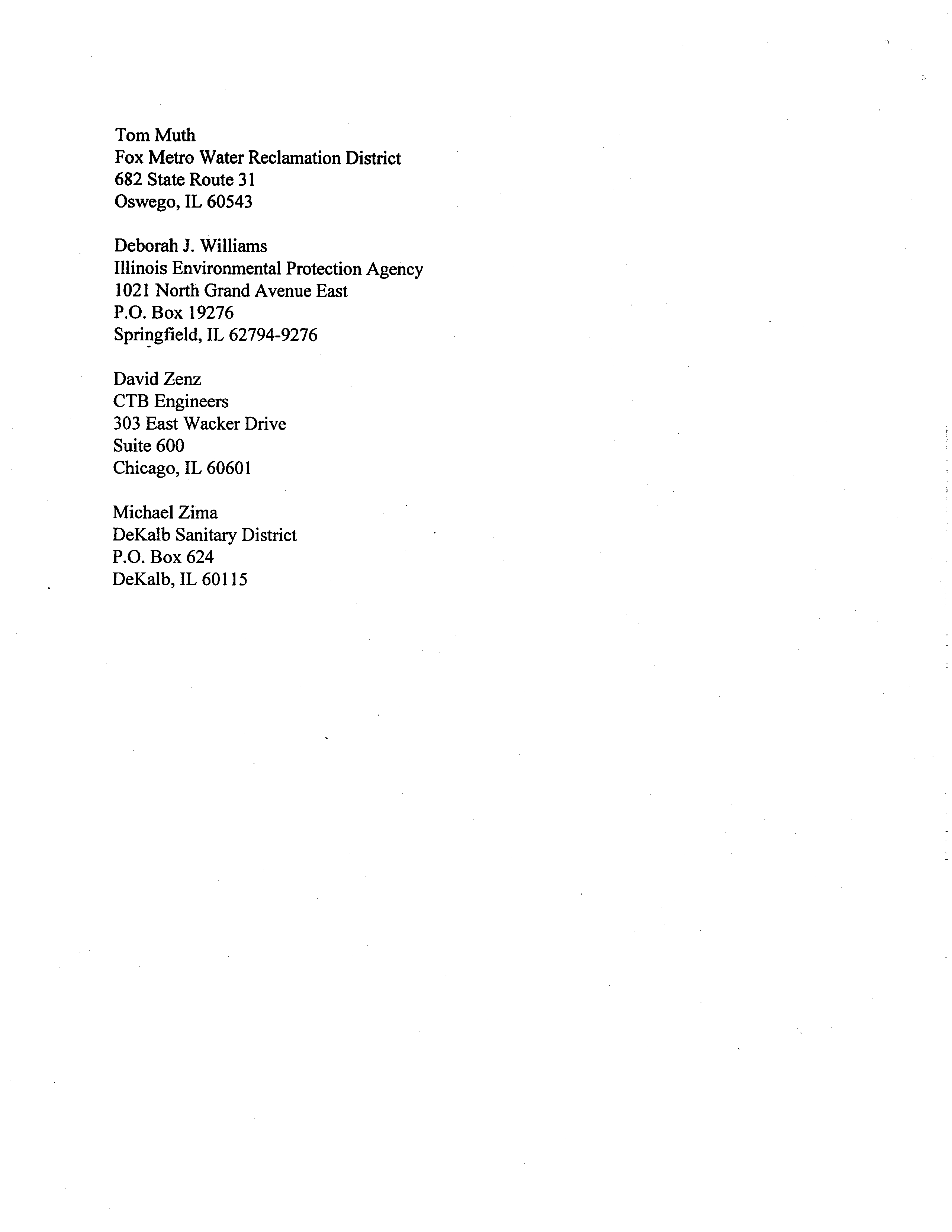R02-19
(Rulemaking
—
Water)
~i2~
~
NOTICE OF FILING
PLEASE TAKENOTICE that on May 15, 2002, the undersigned filed an original and
nine (9) copies ofthe foregoing Comments ofthe Environmental Law and Policy Center Prairie
Rivers Network and Sierra club on Proposed Ammonia Standard Changes with Dorothy Gunn,
Clerk ofthe Pollution Control Board,
100 West Randolph Street, Suite 11-500, Chicago, IL
60601.
One (1) copy ofsaid comments
is hereby served upon each ofyou.
Respectfully Submitted,
BY:
Albert F. Ettinger (Re
o.
3125045)
Counselfor Prairie Rivers Network
Environmental Law and Policy Center
35
East Wacker Drive, Suite 1300
Chicago, IL
60601
May
15,
2002
ILLINOIS POLLUTION CONTROL BOARD
IN THE MATI’ER OF:
PROPOSED AMENDMENTS TO
AMMONIA NITROGEN STANDARDS
35
ILL. ADM. CODE 302.2 12, 302.2 13
AND 304.122
R~EC~VED
CLERR’S OFFICE
ww
152002
STATE OF
ILLINOIS
Pollutj~~~
Control Board
)
)
)
)
)
1-.~RKSO
~y
15 2002
ILLINOIS POLLUTION CONTROLBOARD
smrE
OF1LLII.~OIS
p0~lutIofl
Control
Board
IN THE MATTER
OF:
)
)
PROPOSED AMENDMENTS TO
)
R02-19
AMMONIA NITROGEN STANDARDS
)
(Rulemaking
-
Water)
35 ILL. ADM. CODE 302.212, 302.2 13
)
AND 304.122
)
COMMENTS OF THE ENVIRONMENTAL LAW
AND
POLICY
CENTER PRAIRIE RIVERS NETWORK
AND
SIERRA CLUB
ON PROPOSED AMMONIA STANDARD CHANGES
The EnvironmentalLaw and Policy Center ofthe Midwest, the Illinois Chapter ofthe
Sierra Club and Prairie Rivers Network (collectively “Environmental Groups”) hereby comment
on the proposed changes to the ammonia water quality standard offered by the Illinois
Association of Wastewater Agencies (“IAWA”).
Briefly, the Environmental Groups, take no position regarding the proposed changes to
sections 302.100 and 302.2 12.
There are aspects ofthese proposed changes that pose dangers to
Illinois aquatic lifethat will require careful consideration by IEPA in designing the
implementation rules and permit writing.
The dangers can be addressed
in large part through
careful application ofIllinois’ newantidegradation regulations and adoption by IEPA of
ammonia standard implementation regulations that require developing site-specific criteria for
waters where fingernail clams, endangered mussels, or importantbluegill populations may be
present.
The Environmental Groups support the proposal insofar as it would repeal the portion of
the ammonia standards concerning Effluent Modified Waters (“EMW’s”) through amendments
proposed to sections 302.213 and 304.122.
The Environmental
Groups do not agree with all ofthe self-congratulatory rhetoric and
one-sided history lectures that have accompanied the IAWA proposal. However, because the
rhetoric and lectures are of little relevance, the rhetoric will be treated summarily in Section III
below and history will be addressed only in the attached historical appendix.
1
I.
IfProper Implementation Rules Are Adopted And Other Water Quality
Protections Are Fully Implemented, the Proposed Changes to Section 302.212
Probably Will Not Damage Illinois Aquatic Life.
Representatives ofELPC
and
the Sierra Club met with representatives ofIAWA
informally in 2000
and
2001 regarding the IAWA’s plans for revisions to ammonia standards. At
that time, ELPC and Sierra Club indicated that they would not oppose changes to the ammonia
standards
ifthe proposed changes faithfully tracked the
1999
U.S. EPA ammonianational
criteria document (“1999 NCD”). Unlike some U.S. EPA national criteria documents, the
1999
ammoniadocument is supported by many studies that considered a wide range ofspecies. It
appears that the IAWA proposal does faithfuily trackthe
1999 NCD.
Further, although the potential costs may be exaggerated, it appears that a handful of
Illinois dischargers will incur significant costs if they are forced to meet effluent limits designed
to prevent violations ofthe current Illinois ammonia standards but may avoid such costs if
standards tracking the
1999 NCD
are
adopted.
There are a numberofapproaches possible under the Clean Water Act and the Illinois
Environmental Protection Act to address this situation. Changing Illinois ammonia standards
is
one approach and is the approachthat
has
been embraced by IAWA.
This approach is not
without dangers to Illinois aquatic life, including endangered species. But suchrisks are probably
manageable as to ammonia if Illinois antidegradation standards are rigorously enforced by IEPA.
However, it should be noted that the
1999 NCD states that the criteria it proposes may not
be protective ofthe fingernail clam’ and that the criteria allowed little or no margin ofsafety for
the “recreationally important bluegill”.
(1999 NCD at 80).
The 1999 NCD suggests
development ofsite-specific criteria where sensitive endangered species may be affected by an
ammoniadischarge.
(Ibid).
Moreover, there have been new ammonia studies.
(S~
Letter from Mary Beth Tyson to
Toby Frevert, October21
2001,
with
attached list ofstudies, Hearing Exhibit 2).
These recent
studies indicate that the 1999 NCD may not be protective ofimportantmussel species living in
Illinois waters.
While not all ofthese newmussel studies have been fully peer-reviewed or
finalized, many ofthem have. None ofthe studies can safely be ignored.
The fingernail clam is extremely important to the Illinois environment as the decline of
the fingernail clams had “drastic repercussions on the populations ofducks and fish”.
Ex. A.
Sparks, Rand Ross P. Identification ofToxic Substances in the Upper Illinois River (1992)
2
If Illinois adopts the proposed standard based on the
1999 NCD, there can be no
presumption that Illinois standards areprotective ofmussels. The antidegradation standards
clearly require protection ofexisting uses.
Accordingly, any permit seeking a new or expanded
discharge ofammonia must be accompanied by proofthat the discharge will not affect mussel
beds or any otherexisting use, be it ofbiological, recreational orother significance. In most
cases, this could probably be done by showing that no such sensitive uses are present in any area
that will be affected by the discharge.
Still further, it must be recognized that a new Illinois ammonia standard that renders the
standard less stringent cannot be used to. affect any permit until IEPA adopts the necessary
implementation rules and the standard, with the implementation rules, are approvedby U.S.
EPA. Under 40 CFR §131.6(f), standards submissions to U.S. EPA must be accompanied by
“information on general policies applicable”
..
.
“which may affect the
standard’s
application
and implementation.” No change in standards is effective ormay be used in writing effective
permits until it is approved by U.S. EPA. 33
U.S.C. §l313(c)(3); 40 C.F.R. §131.21; Alaska
Clean Water Network v. Clarke,
1997 U.S. Dist. Lexis
11144 (W.D. Wash.
1997). Hopefully, the
science regarding mussel toxicity will be more clear by the time that U.S. EPA has to decide
whether or not to
approve a change to the Illinbis ammonia standard.
2
II.
The Board
Should Delete the
Portion of
the Current Ammonia Standards
Regarding Effluent Modified Waters.
The Environmental Groups agree without reservation that the provisions regarding
EMWs should be deleted from Illinois ammonia standards.
Our reasons for supporting this
change, however, are somewhat different than IAWA’s and follow directly from the requirements
ofthe Clean Water Act and the regulations developed by U.S. EPA and the Board to implement
the Clean Water Act.
The EMW provisions allow certain waters to be designated as “effluent modified” and
waive chronic ammonia limits as to such waters.
However, the Clean Water Act does not allow
a state to downgrade a use designation to allowgreater pollution loadingsjust because the state
believes it is
inconvenient or expensiveto protect the designated use. Basically it must be shown,
after allowing public participation,
that the water is inherently limited ecologically orthat
2
Nonetheless, if U.S.
EPA approves a change to the Illinois ammonia standard without
the effect ofammonia on mussels,
fingernail clams and other spcies being fully known, there
is a
risk ofdamage to Illinois aquatic life even if Illinois EPA properly implements the new
antidegradation rules.
The antidegradation rules would not apply to an increased discharge of
ammonia that was already permitted even if the discharger had not previously discharged
ammonia atthe levels allowed by the permit.
The extent ofthis danger is not known.
3
controls needed to protect the designated use “would result in substantial and widespread
economic and social impact.” 40 CFR §13 1.10 (g)(6).
In all cases, the existing use must be
protected.
As the Board is aware, regulations established under the Clean Water Act require that
states designate uses for all waters ofthe state, 40 CFR
§
13110(a), and criteria to protect those
uses. Regulations prohibit the issuance ofpermits that will allow a discharge that causes or
contributes to a violation ofthe criteria designed to protect uses. 40 CFR§122.44. In Illinois,
almost all waters are designated as “general use” (see 35 Ill. Adm Code 303.441
listing
exceptions) Permits cannot be issued that will allow violations ofthe criteria adopted by the
Board to protect aquatic life except in the limited circumstances in which a mixing zone is
allowed.
The Clean Water Act does allow for the use ofa water to be redesignated to allowgreater
pollution loadings or concentrations, but the circumstances in which this can be’ done are
extremely limited.
A waterthat has been designated as “general use” can be redesignated as
“secondary contact” (or given some other level ofusedesignation that did not require application
ofgeneral
use criteria) only in the limited circumstances provided by
40 CFR 131.10(g). That
regulation provides that removing a use requires a “Use Attainability Analysis” and states:
(g)
States may remove a designated use which
is
not
an existing use, as defined in §
131.3, orestablish
sub-categories ofa use if the State can
demonstrate that attaining the designated use is not
feasible because:
(1)
Naturally occurring pollutant concentrations
prevent the attainmentofthe use; or
(2)
Natural, ephemeral, intermittent or low flow
conditions or water levels preventtheattainment
ofthe use, unless these conditions may be compensated
for by the discharge ofsufficient volume
ofeffluent discharges without violating State water
conservation requirements to enable uses to be
met; or
(3)
Human caused conditions or sources of pollution
prevent the attainment ofthe use and cannot
be remedied or would cause more environmental
damage to correct than to leave
in place; or
(4)
Dams, diversions or othertypes ofhydrologic
modifications preclude the attainment ofthe
use, and it is not feasible to restore the water body
to its original condition or to operate such modification
in a way that would result in the attainment
4
ofthe use; or
(5)
Physical conditions related to the natural
features ofthe waterbody, such asthe lack ofa
proper substrate, cover, flow, depth, poois, riffles,
and the like, unrelated to water quality, preclude
attainment ofaquatic life protection uses; or
(6)
Controls more stringent thanthose required
by sections 301(b) and 306 ofthe Act would result
in substantial and widespread economic and
social impact.
The effluent modified waters provisions, now contained in 35 Ill. Adm Code 302.213 and
304.122, do not fit comfortably with the Clean Water Act. Indeed, unless the EMW provisions
are interpreted very restrictively, they cannot be reconciled with the Clean Water Act at all.
Essentially, if the EMW provisions were interpreted in a manner that did not require strict
compliance with the “Use Attainability Analysis” requirements of40 CFR 131.10(g) and the
principles ofthe Clean Water Act set forth in 33 U.S.C. §125 1, the EMW provisions would be
illegal and
could never have been approved by U.S. EPA.
It was never clear how the Board intended the EMW provisions to be implemented and
perhaps the Board simply expected the matter to be decided by the IEPA in accordance with state
and federal law. In any event, IEPA has been persuaded to issue regulations, 35 Ill. Adm. Code
part
355,
that
interpret the EMW provisions narrowly, basically requiring that the showings be
made that would be necessary to perform a use attainability analysis under 40 CFR 131.10(g).
So limited, the EMW provisions are not pernicious. They are not terribly useful to anyone
either.3 Moreover, no reason appears why Illinois should in effect have special Use Attainability
Analysis regulations applicable only to chronic ammonia standards.
III
The Science And Wastewater Treatment For Ammonia Have Improved And
Must Continue To Improve.
Certain rhetorical flourishes and
statements made by IAWA representatives in the course
of these proceedings require a briefresponse to avoid leaving the impression that everyone is in
agreement with this hyperbole.
First, the “I told you so’s” suggesting that Illinois ammonia standards have always been
fine and the past controversies were all caused by erratic U.S. EPA science and policies are not
justified. It is simply not true that the
1999 NCD indicates that the pre-1996 Illinois
ammonia
~ IAWA takes no satisfaction from the EMW provisions as they have been limited
t~.
accord with the Clean Water Act.
5
standards were protective or that ammoniadischarge concentrations of
1.5
mg/L in the summer
and 4.0 mg/L in the winter are always acceptable.
In fact, to the creditof lAWNs scientific
consultants, IAWA’sproposal largely tracksthe
1999 NCD and, clearly recognizes that Illinois
cannot go back to anything like the pre-1996 standards. The IAWA proposal also implicitly
recognizes that, depending on pH, temperature and dilution,
many permits must contain effluent
limits tighter than the
1 .5(summer)/4.O(winter) mg/L level to be protective. Further, following
the 1999 NCD, the IAWA proposal makes careful judgements regarding early life stages.4
Second, it is clear that sewerage treatment plants do not generally experience
prohibitively high costs if they seek to treat ammonia beyond the level necessary to meet
1 .5(summer)/4.0(winter) effluent concentrations.
The very exhibits offered by IAWA show
sewerage treatment plants not coming close to discharging ammonia at the 1.5/4.0 concentrations
for years.
See Pre-filed Testimony ofTim Bachman attachments
4
&
5.
Certainly, there should
not be any presumption in futureproceedings that ammonia effluent limits as high as
1 .5(sunnner)/4.0(winter) mg/L are protective or economically necessary.
4mesejudgements may, however, need to be the subject offurther research and be
reconsidered in the context ofdeveloping implementation rules given the remarks ofDr. Burr,
quoted in the January 18, 2002 letter ofThomas Muth
to David Pfeiffer.
See Exhibit
1.
6
CONCLUSION
We wish we could conclude now with the statementthat all ofIllinois’ problems with
ammonia are nowbehind itand the Board can conclusively end all consideration ofammonia
standards by adopting the IAWA proposal.
Unfortunately, the IAWAproposal is ultimately
based on tentative science that may very well have to be revised in the future.
In any event, improved science and technological improvements will be needed if Illinois
is to accommodate a growing population and economy without further damaging Illinois’ rivers,
lakes, wetlands and streams.
4
F. Ettinger
Environmental Law and Policy Center
35 East Wacker
Drive, Suite
1300
Chicago, IL 60601
Cynthia Skrukrud, PhD.
Clean Water Advocate
Sierra Club, Illinois Chapter
Robert Moore
Executive Director
Prairie Rivers Network
May 15, 2002
7
HISTORICAL APPENDIX
To briefly summarize a long history that took place over a five year period,
IEPA in
1994 filed its ammonia proposal that contained the EMW provisions.
The Environmental
Groups do not know what IEPA told IAWA as to how the EMW provisions would be interpreted
and implemented, but the Environmental Groups were told that the EMW provisions would only
apply to drainage ditches that were ofno use for outdoor recreation and ofno ecological, value.
This was confirmed by IEPA briefs filed in R94-1(B) that stated that the EMWs would solely
consist of“small effluent dominated and ecologically limited resources.”Agency’s Final
Comments, filed April 6,
1995 p.3.
The Environmental Groups were disturbed to learn during the R94-1(b)
proceedings that
certain dischargers claimed that they had been told that miles ofthe Fox River and other valuable
‘cvaters would be designated as EMWs. Accordingly, the Environmental Groups asked the Board
“to eliminate or at least clarify the provisions regarding effluent modified waters to assure that a
water body may only be identifed as an EMW if is small,
effluent dominated and ecologically
limited.”
Post-Hearing Comments ofPublic Hearing Participants, March 29,
1996 p.1.
Assuming that IEPA would comply with the requirements ofthe CWA, the
environmental groups expected that afterthe Board issued its final decision on the standards,
IEPA would develop implementation rules that would go through the agency rulemaking process
before any permits were issued that used the new EMW provisions. Conversation with IEPA
officials in late 1996 confirmed these expectations. We were, accordingly, appalled to learn
during Spring
1997 that IEPA had decided to interpretthe EMW provisions to allow EMW
designations to take place in every Illinois water, no matter how sensitive or valuable, and that
IEPA -without establishing implementation rules or securing U.S. EPA approval of the standards
and implementation rules under 33
U.S.C.
13 13(c) and 40
CFR 131.21
-
had issued numerous
permits containing EMWs designations in highly valued and sensitive Illinois waters.
In the summer and fall of 1997, it was brought to U.S. EPA’s attention that IEPA’s
issuance ofillegal permits had to stop.
In Fall
1997, the issuance ofpermits with the illegally
loose and improperly established EMW provisions was stopped. Many permits, had
been issued,
including permits for discharges to the Cache River, the Little Vermilion River, Manhattan Creek
and tributaries to the Mackinaw and Kishwaukee Rivers. Based on IEPA biological data, it is
believed that this permit issuance resulted in substantial damage to Illinois aquatic life.
As a result ofthis controversy, few or no permits were issued involving ammonia
discharges for over a year and a substantial permit backlog developed. However, during
1998
and 1999, the safeguards on use of the EMW provisions, now contained in 35 Ill. Adm. Code
part
355
were developed. These safeguards reconciled the EMW provisions with governing
federal and state law, the standards and implementation rules were approved by U.S. EPA, and
IEPA was able to issue permits again.
In retrospect, it is clear that the process would have beenmuch smoother if IEPA had
submitted draft implementation rules with its ammonia proposal as it did later with its Great
Lakes and antidegradation standards proposals. Fortunately, IAWA has suppliedthe Board in its
proposal with a clear indication ofhowit is expected that the standards will be implemented.
This should greatly facilitate the IEPA rulemaking that
is necessary before the standard and
implementation rules can be presented to U.S. EPA for approval.
The Environmental Groups are willing to supply documents supporting each ofthe statements
made in this footnote concerning historical events. However, in view oftheir marginal relevance
to this appendix, it does not seem worth the paper to include such exhibits here.
EXHIBIT
tasse_
sat
UOcUMENTATION
1.
WOI1~
‘
7.
—.
-
PAQE
ILENR/RE-.WR-92/07
~d~SM!~
Msn*os N..
.
.
.
Identification of Toxic Substances
in the Upper Illinois River
~iq,i.to.w~”
-
.
iuc~ard
E.
Sparks
and Philippe
E. Ross
S.
PS~fuv,niq4
rØ.I~,.($oA
.i’~O~
Ni~~
Ads..
—
Rfver
Research
Laboratory
Forbes
Biological
Station
.
Illinois
Natural
History
Survey
.
P.O.
Box
599
Havana,
II
62644
.
ZIY~W~*
U&tft~
—
89/215
11.c~c~c~
,~‘
(~
WR3691
(0~
iz
ooI~s,r1M~orpl~kuu&a
Hum. se~
Addfsss
Illinois
Department
of
Energy
and
Natural
Resources
Office’of’Research and Planñii~g
325 West
Adams
Street
Springfield._IL.
62704-1892
23.
Typ.
~
~io~it
& Pstlod Covsrø
-
“
Is.
I—
~
ii.
ass*~um
ei~
Between 1955 and 1958, several abundant species of acquatic insects, snails and
finger-
nail
clams
practically
disappeared
from
the upper Illinois River.
These declines had
equally drastic repercussions on the populations of ducks and fish that fed upon
these
invertebrates.
The situation changed very little into the 1980s, despite improvements
in water quality.
This research found that porewater from relevant river sediments
contains a toxic factor that inhibits the flitering ability of fingernail clams and
also
negatively effects
the
water flea, while stimulating alga and bacteria growth.
All evidence points~
to
aim~oniaas
the
toxic agent.
Also,
at
two sites, the porewater
contained
toxic
oil products, including polycyclic
aromatic
hydrocarbons, such as
naphthalene.
A three phase
Toxicity
Identification and Evaluation
methodology
was
utilized in reaching these conclusions.
17.
QO~Nfl~
M.b’.I.
a. nu~t~
Water Pollution, Toxicity, Water Pollution Effects
(Animals),
Sedimants, Sedimentation, Suspended Sediments
6.
~
Tu,mz
Sedimentation
-
Ill1n~i~
River
Toxicity
-
Illinois R1~er
-
Water Pollution
-
Illinois River
C.
COSATI
Pm.,GA’UUØ
Biolooical
and
~ed~cal_5ci~
1&~si!.~Wtv*.tsn(fl.~~
restriction
on
distribution..
Available
at
II
Depository
Libraries
or
from
National Technical
Information Service,
cr~ir~nc’,n~l
IA
21.
No.
of
Pan.,
CERTIFICATE OF SERVICE
I, Albert F. Ettinger, certify that,
on May 15, 2002 I mailed, with proper postage on
recycled paper, the foregoing Comments ofthe Environmental Law and Policy Center Prairie
Rivers Network and
Sierra ClubonProposedAmmonia
Standard Changes the addresses on the
attached service list.
Environmental Law and Policy Center
35 East Wacker Drive, Suite
1300
Chicago, IL
60601
May
1.5,
2002
SERVICE LIST
R02-19
Tim Bachman
Urbana/Champaign Sanitary District
1100 East University
P.O. Box 669
Urbana, IL
61803
Mike Callahan
Bloomington Normal Water Reclamation
District
P.O. Box 3307
Bloomington, IL 6 1702-3307
Larry Cox
Downers Grove Sanitary District
2710 Curtiss Street
Downers Grove, IL 60515
Dennis Daffield
Department ofPublic Works
City ofJoliet
921 East Washington Street
Joliet, IL 60433
Jim Daugherty
Thom Creek Basin Sanitary District
700 West End Avenue
Chicago Heights, IL 60417
Sheila Deely
Gardner, Carton &
Douglas
321 North Clark Street, #3400
Chicago, IL 60610-4795
Susan M. Franzetti
Sonnsenchein Nath &
Rosenthal
8000 Sears Tower
Chicago, IL 60606
Lisa M. Frede
Chemical Industry Council
9801
West Higgins Road
Suite 515
Rosemont, IL 60018
Catherine F. Glenn
Illinois Pollution Control Board
100 West Randolph Street, Suite 11-500
Chicago, IL 60601
Dorothy Gunn
Clerk, Pollution Control Board
100 West Randolph Street; Suite 11-500
Chicago, IL 60601
James T. Harrington
Ross & Hardies
150 North Michigan, Suite 2500
Chicago, IL 60601
Katherine Hodge
Hodge Dwyer Zeman
3150 Roland Avenue
P.O.Box 5776
Springfield, IL 62705
Margaret P. Howard
Hedinger & Howard
1225 South Sixth Street
Springfield, IL
62705-5776
Richard Lanyon
Metropolitan Water Reclamation
District ofChicago, Env. Monitoring Div.
6001
Pershing Road
Cicero, IL 60804
Tom Muth
Fox Metro Water Reclamation District
682 State Route 31
Oswego,
IL
60543
Deborah J. Williams
Illinois Environmental
Protection Agency
1021 NorthGrandAvenue
East
P.O. Box 19276
Springfield,
IL 62794-9276
David Zenz
CTB Engineers
303 East Wacker Drive
Suite 600
Chicago, IL
60601
MichaelZima
DeKalb Sanitary District
P.O. Box 624
DeKalb, IL 60115
